More often than not I use two distinct shapes of a cop. The first is a "cone" shape. This is the shape I started using from my very first class in spinning. It seemed logical. Start winding on with each strand aligned with the next, up and down the spindle. It ends up getting fatter at the end next to the whorl because on that end the strands won't fall off each other. It tapers towards the other end because that is the only way to keep the whole thing stable. The yarn pictured to the right is the second yarn I ever spun, made from roving that I pre-drafted to width and then simply added twist and wound onto the spindle.
And here is the first bit of yarn I spun with actual drafting going on. See how we still have the parallel-wound cone going on?
The benefit of winding in a parallel manner is that since all the strands run the same direction, they snug down against each other to create a very dense cop without much air in it. The downside is that you are limited by the width of your whorl. Once your cop reaches that width it becomes increasingly difficult, if not impossible, to keep winding on. The yarn will no longer stay in the handy notch carved into the whorl and this can cause all sorts of "fun" problems with yarn flying about. Another weakness is that it is possible to develop loose loops at the bottom of the cop that want to spiral undone down the shaft.
One solution to this problem is to use a spindle with a long shaft and to build a really long cop with a very limited taper. This still only allows you to pack on fiber to the width of the whorl, but gives you a lot more area in which to put all that yarn you are spinning. This doesn't completely solve the problem of the bottom of the cop getting loose as you work, but since the bottom of the cop isn't at such a steep angle, those loose loops are less likely to form.
My preferred solution to these problems is cross-winding. You cross wind by spiraling your single (or plied yarn) up and down the shaft of the spindle. Because the strands now criss-cross each other, they are able to hold down lower layers. But because they do cross over lower strands, this creates a gap where there is air in the cop. This isn't a bad thing, but it does mean that the cop builds up bulk faster than if the strands were laying side-by-side. It also means the center of the cop tends to get larger faster than the ends, creating what I think of as a "pregnant cop" or a "football cop".
Here is a little "football cop" just getting started. You can see how it tapers at both ends. If you keep the bulk of this cop from coming abut the bottom of the whorl (necessary in this case because of the carved-out shape of the underside of the whorl) you always have a narrow point to wrap your yarn before bringing it up to the hook. This gives you the leverage and friction you need to keep the yarn in the notch and you won't have the problem of your yarn leaping off the hook while you're spinning. When the cop can actually press up against the underside of the whorl, the shape changes a little and becomes more cone-like. You can keep the belly growing by cross-winding (or even straight-winding) more yarn lower down so that the entire shape shifts down the spindle towards the end of the shaft.
This image demonstrates how the shape of the cop changes when up against the whorl. The end that would usually taper is doubled back to make that part bulk up more. You can end up having a conical shaped cop again if you don't move the bulk of the winding down the shaft at this point.
I like using the best of both worlds for my cops. Personally, I like the look and feel of a tightly-wound conical cop. I usually start that way. If, at any point, I start seeing looseness in my cop or loops trying to work their way off the bottom, I simply cross-wind for a little while to "tie everything down". When I feel that I've stabilized my work, I return to straight-winding again. In this way you build a cop that is both stable and dense, maximizing how much yarn you can get on the spindle.
If, as you work, you find that you have more fiber than you think will fit using a cone you can always start cross-winding more and also concentrate your straight-winding around the center of the cop. This will build up a nice little belly that over time can get quite big.
Just how much can you get on a spindle? A lot more than you think. This cop is over six ounces of fiber. That was on a Kundert spindle that weighs just a little more than an ounce, and while it wasn't fun towards the end I still could have packed even more fiber on this.
According to Abby Franquemont, Andean spinners can get a full pound of plied yarn on their bottom-whorl spindles. Personally, that's a whole lot more than I want to do!
I really think that pictures do even more than words to show what I'm doing, so here is a series of one of my recent projects. The fiber spun is dyed kid mohair. You can see by the end that the "belly" on my cop is bigger than the whorl of the spindle, allowing me to put all my fiber on one spindle without running out of space.
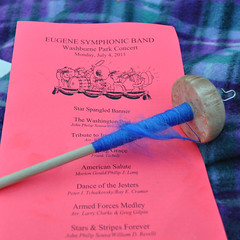

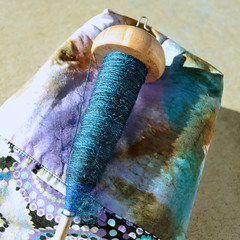
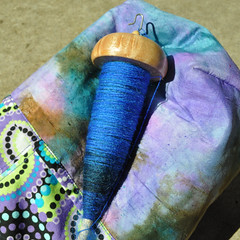

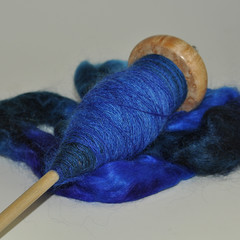
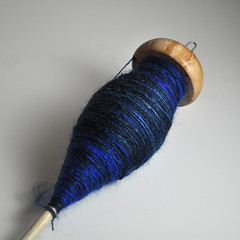

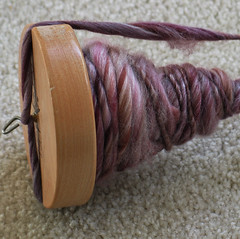
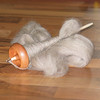
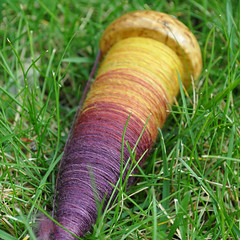

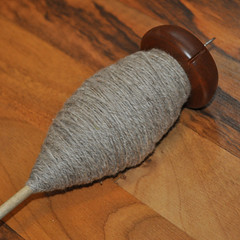
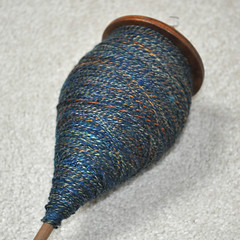
3 comments:
I drop a cd, or that blank clear plastic 'pretend' cd that comes on top of a new stack of blank cd's onto my drop spindle to widen out the base of the whorl. Initially I did it permit plying a larger than usual batch of yarn. I just used two bits of tape rolled inside out over my finger to stick the cd to surface of the whorl... I never did take it off either. And I did not know that is what it's called, a 'cop' thanks!
Thank you for this post! This is really helpful. I've been spinning for a while now but I've never been very good at building up a large, stable cop.
Thank you. This is very helpful.
Post a Comment